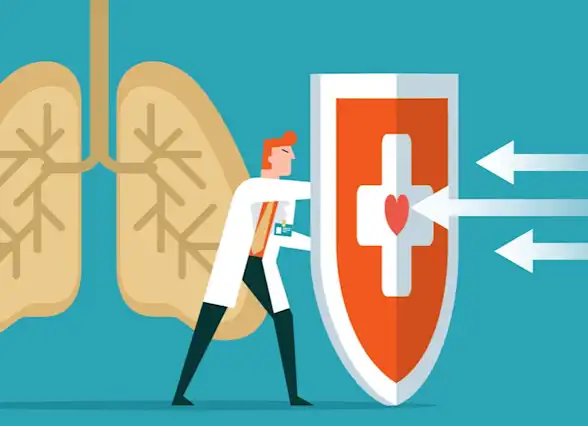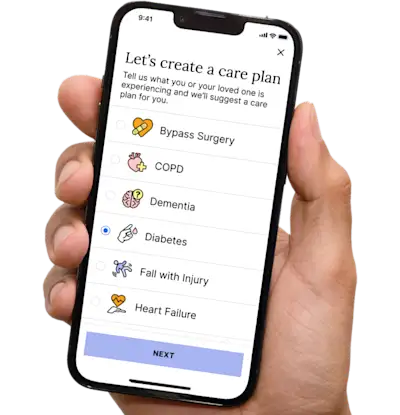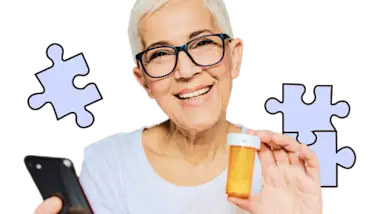Pulmonary Rehabilitation, How it Works
Pulmonary rehabilitation (rehab) is a multidisciplinary, multimethod approach to better respiratory health and quality of life using tailored interventions.
Get insurance benefits, legal documents, and medical records in one place

Helpful Highlights
Pulmonary rehabilitation (rehab) programs are individualized, structured, multidisciplinary, and typically involve several key components.
The various components flow with the three phases of the program: Phase 1, inpatient rehab; Phase 2, outpatient rehab, and Phase 3, maintenance rehab.
When properly followed, pulmonary rehab programs reduce hospital readmission by 56% within the year after discharge.
Caregivers play an important role throughout the pulmonary rehab process, especially in maintaining attendance, adopting behavioral change, and engaging in ongoing maintenance.
Pulmonary rehabilitation (rehab) is a structured and multidisciplinary* program designed to improve respiratory health and overall quality of life for individuals with chronic respiratory conditions. It addresses both the physical and psychological aspects of chronic respiratory conditions, aiming to enhance an individual's ability to manage their health and lead a more active and fulfilling life.
*In this context, the rehab team involves several licensed clinicians, such as physicians, nurses, respiratory therapists, physiotherapists, dieticians, counselors, and other healthcare professionals.
The process typically involves several key components:
Assessment and individualized planning
The journey begins with a thorough assessment of your loved one's medical history, current health status, and specific needs. The rehab team then collaborates to create an individualized rehabilitation plan.
Education
You and your loved one receive education on their respiratory condition, symptom management, medications, and lifestyle modifications. Understanding the condition empowers you both to take an active role in self-management. Topics covered are anatomy, physiology, breathing techniques, and medication management, which includes things like the best time of day to take medications.
Exercise
Because of breathing challenges, people with chronic lung disease tend to avoid exercise. However, the right amount and type of exercise have many benefits. It can improve heart and muscle strength, increase energy levels, and help them use oxygen more efficiently.
A crucial aspect of pulmonary rehab involves structured exercise programs tailored to your loved one's abilities and health status. They are monitored and taught to exercise safely by paying attention to their breathing and oxygen levels and learning how to modify aerobic exercises, strength training, and flexibility exercises. The goal is to improve cardiovascular fitness, respiratory muscle strength, and overall physical function.
Breathing techniques and oxygenation
Your loved one is taught techniques to enhance respiratory muscle strength and control, such as pursed-lipped breathing and diaphragmatic exercises, along with other breathing strategies to help increase oxygen levels and better manage symptoms, including fear and panic. These exercises help individuals better manage their breathing, reduce shortness of breath, and improve overall lung function to keep breathing issues in check and avoid supplementary oxygen. Others learn how and when to use their oxygen correctly to maximize quality of life.
Psychosocial support
Dealing with a chronic respiratory condition can impact mental health. Pulmonary rehab often includes psychosocial support through counseling services to address anxiety, depression, and stress related to the respiratory condition. Counseling relative to caring for a loved one in pulmonary rehab is often made available for caregivers, as well.
Nutritional counseling
A proper diet plays a role in managing respiratory conditions. Nutritional guidance is provided to ensure your loved one maintains a balanced diet that supports overall health and energy levels.
Being overweight or obese can increase shortness of breath, and being underweight can lower the ability to fight infections. Plus, it can be hard to eat when short of breath. Your loved one will learn to prepare nutritious food and eat comfortably without overwork.
Behavioral change strategies
Pulmonary rehab programs may incorporate strategies to promote long-term behavior change, encouraging your loved one to adopt and maintain healthier lifestyles.
Monitoring and follow-up
Regular assessments and progress evaluations are conducted throughout the rehab process. Healthcare professionals monitor changes in symptoms, physical function, and overall well-being. Adjustments to the rehabilitation plan are made as needed.
Transition to maintenance
Your loved one will feel better when they use the tools acquired during pulmonary rehab and should go on using them throughout their life to help avoid hospitalizations, complications, and other issues.
Following completion of the structured program, individuals are encouraged to continue incorporating learned skills and exercises into their daily lives, transitioning to a maintenance phase to sustain long-term benefits.
Many programs offer a maintenance option that allows clients to return for exercise classes and support groups after the program is over. These programs also nurture the community that participants form during pulmonary rehab programs.
RESOURCES
American Lung Association - How Pulmonary Rehab Helps You Breathe
NIH National Heart, Lung, and Blood Institute
Stefan, M.S., Pekow, P.S., Priya, A., ZuWallack, R., Spitzer, K.A., Lagu, T.C., Pack, Q.R., Pinto-Plata, V.M., Mazor, K.M., & Lindenaur, P.K. (2021). Association between Initiation of pulmonary rehabilitation and rehospitalizations in patients hospitalized with chronic obstructive pulmonary disease. American Journal of Respiratory and Critical Care Medicine, 204(9), 1015-1023. DOI
No content in this app, regardless of date, should ever be used as a substitute for direct medical advice from your doctor or other qualified clinician.
Get more support and guidance on insurance benefits, medical records and legal forms.
Helpful brings together your insurance benefits, legal documents, and medical records in one personalized place — so you always know what you have, and never have to search again.

Technology for Health Tasks. Mental Health for the Tough Stuff.
Helpful connects your medical records, insurance, and caregiving tasks automatically. And when you need more than logistics, a therapist is here to guide you.
In-Network and Covered
For Individuals, Couples and Families
HIPAA Compliant, Data Stays Private


Healthcare Tasks Simplified

From syncing records to spotting drug interactions, Helpful does the heavy lifting, turning complex health info into clear tasks and showing you benefits you can actually use, giving you clarity and control over your care.

In-Network Mental Health

Our licensed therapists are here to support you and your loved ones through stress, burnout, and life’s hardest moments, with an inclusive, compassionate approach that works with most insurance plans.

Create Legal Documents

Plan ahead by creating will, trusts, advance directives and more, that ensure your wishes are honored in the event you can’t speak for yourself -with Helpful guiding you every step of the way.